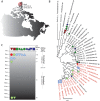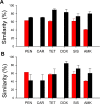Functional characterization of bacteria isolated from ancient arctic soil exposes diverse resistance mechanisms to modern antibiotics
- PMID: 25807523
- PMCID: PMC4373940
- DOI: 10.1371/journal.pone.0069533
Functional characterization of bacteria isolated from ancient arctic soil exposes diverse resistance mechanisms to modern antibiotics
Abstract
Using functional metagenomics to study the resistomes of bacterial communities isolated from different layers of the Canadian high Arctic permafrost, we show that microbial communities harbored diverse resistance mechanisms at least 5,000 years ago. Among bacteria sampled from the ancient layers of a permafrost core, we isolated eight genes conferring clinical levels of resistance against aminoglycoside, β-lactam and tetracycline antibiotics that are naturally produced by microorganisms. Among these resistance genes, four also conferred resistance against amikacin, a modern semi-synthetic antibiotic that does not naturally occur in microorganisms. In bacteria sampled from the overlaying active layer, we isolated ten different genes conferring resistance to all six antibiotics tested in this study, including aminoglycoside, β-lactam and tetracycline variants that are naturally produced by microorganisms as well as semi-synthetic variants produced in the laboratory. On average, we found that resistance genes found in permafrost bacteria conferred lower levels of resistance against clinically relevant antibiotics than resistance genes sampled from the active layer. Our results demonstrate that antibiotic resistance genes were functionally diverse prior to the anthropogenic use of antibiotics, contributing to the evolution of natural reservoirs of resistance genes.
Conflict of interest statement
Figures




References
Publication types
MeSH terms
Substances
LinkOut - more resources
Full Text Sources
Other Literature Sources
Medical

